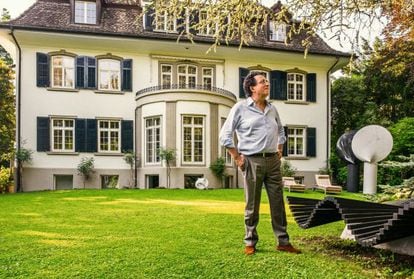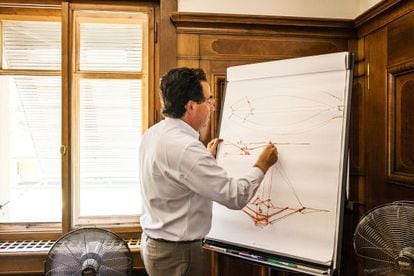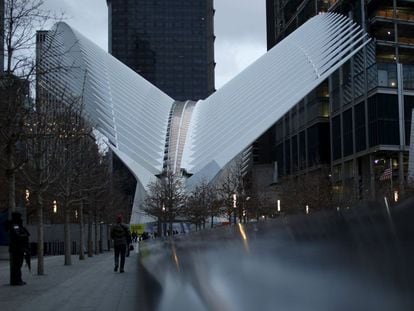Santiago Calatrava: “Self-criticism is necessary”
EL PAÍS meets one of the most controversial architects of his time

Santiago Calatrava speaks six languages, and in just about all of them, along with a few others, newspapers around the world have converted the Spanish architect into one of the most controversial members of his profession. Italian journalists have described his bridge over Venice’s Grand Canal as an “imbarazzante serie de errori” (embarrassing series of mistakes), while The New York Times in 2013 headlined one story: “A star architect leaves some clients fuming”, listing the cost overruns, delays, slip ups, and leaks that have led to a number of high-profile lawsuits around the world. His project at Ground Zero in Manhattan, a vast underground interchange crowned by two wings at the feet of the new skyscrapers, is now four years behind schedule and looks set to run $4 billion over budget, twice the original cost. And that’s without going into the controversy of his emblematic designs in Valencia’s City of the Arts and Sciences.
Calatrava’s initial response to the media feeding frenzy was to keep a low profile. But, angry at the criticism, he has now decided to tell his side of the story, agreeing to meet EL PAÍS at his elegant lakeside home in Zurich. “If you hide away, and other people are making trouble for you, in the end you have to say, ‘Come on! Come here and just look.’ The whole thing has been blown out of proportion.” So far, Calatrava is winning the lawsuits: he was absolved in Venice, and two courts in Spain have thrown out accusations that he charged for work he never undertook; a court in Valencia has partially upheld his claims for compensation for libel from a Spanish website (calatravatelaclava.com), while he reached an out-of court settlement with a winery in La Rioja unhappy with his work. He is appealing the €2.9 million fine issued against him in relation to problems with the roof of a conference center in the northern city of Oviedo.
So far, Calatrava is winning the lawsuits: he was absolved in Venice, and two courts in Spain have thrown out accusations that he charged for work he never undertook
In the meantime, the media charm offensive is in full swing. Over the course of two days, albeit under the watchful eyes of his PR director, he shows us round his home and his studio, and is more than happy to discuss the many controversies he has become embroiled in.
We arrive at his home and are greeted by Mike Pfister, his right-hand man, who tells us that Calatrava is taking a pre-lunch nap. The architect follows a daily routine that begins at 5.45am, when he goes running by the lake, followed by breakfast, and then he spends three hours painting and drawing.
Our first glimpse of Calatrava is from behind, in his meeting room. He’s talking in French to one of his disciples about a design for a bridge in China, which will be his first move into Asia. He then turns to Pfister and tells him something in German, then back to French, and finally to us, in Spanish, explaining the Latin roots of the word religion.
Born in 1951 in the small Valencian community of Benimámet, he was the youngest of five siblings, all much older than him. His father, who he says encouraged his artistic tendencies, died when he was 12. He was then sent to live with his uncle’s family. At the age of eight he began studying art, and from the age of 13 spent the following four summers living with a Swiss family, where he learned French and German. At 17 he moved to Paris to study Fine Arts, but the riots of 1968 frustrated those plans, and so he returned to Valencia and began studying architecture. Then, one day, he came across a book about Le Corbusier, which he says changed his life. His offices in Zurich are a stone’s throw from the French architect’s only construction in Switzerland.
Calatrava rarely responds directly to a question, instead answering through metaphors, anecdotes, and stories that often invoke the great artists: asked if he believes his work will endure through the centuries, he recalls the words of Spanish writer Antonio Machado.

“Those who dream of doing things that will be remembered think like Machado: I never pursued the glory of leaving something of my song in the memories of men.”
And what are you pursuing?
“The same as Machado: messages in a bottle.”
His Spanish has lost its Valencian intonation, and after living abroad for so many years, his accent is now like Switzerland: neutral
His Spanish has lost its Valencian intonation, and after living abroad for so many years, his accent is now like Switzerland: neutral. He moved there four decades ago, aged 22, after finishing his architectural studies, matriculating at the Polytechnic Institute, where Einstein studied. After completing his doctorate he soon began making a name for himself: “I realized I could create works of art with the tools of architecture and engineering.” To celebrate the 125th anniversary of the Polytechnic he suspended a glass swimming pool from the inside of the library dome: “It was filled with water and people bathed naked in it, even the dean. It was wonderful to see their bodies splashing about from underneath.”
He met his Swiss wife, Robertina Marangoini, a year after arriving in Zurich. They married soon afterwards, and she became his business manager. Thanks to her connections, Calatrava was introduced into the higher echelons of Swiss society.
They’ve been together for 42 years and have four children. The couple spends the winters in New York and the summers in Zurich, when they are not traveling. Calatrava’s career took off in 1990, and Marangani says the next 15 years were a whirlwind, and their happiest time. Along the way he has won many international prizes and been invited to build some of the world’s most prestigious buildings. “We went to live in Paris, it was marvelous,” she says, adding: “The last few years have been hard. Now all I seem to do is answer letters and talk to lawyers. We have to protect ourselves, which we have, but not enough.”
Marangoni is Calatrava’s shadow. They make a perfect team: he is the seducer, making the broad brushstrokes; she takes care of the details. Ingvar Nohlin of Swedish engineering company HSB, who oversaw the Turning Torso residential tower in Malmo in 2001, remembers negotiating Calatrava’s fees with Marangoni. She wanted 16 percent of the final cost of the project. “You’ve got to be joking,” he says he told her. “Things don't work like that in Sweden,” explaining that such a deal would be an invitation to allow costs to overrun. Calatrava and Marangoni negotiated the same final costs deal in Valencia, says Ignacio Blanco, a former United Left deputy in the region’s parliament. “The overrun costs have been significant, meaning he has made a lot of money at the taxpayer’s expense,” says Blanco, adding that Calatrava billed Valencia City Hall almost €100 million over the 20 years it took to build the City of Arts and Sciences.

Instead, Nohlin offered Calatrava and Marangoni 16 percent of the initial budget for the Turning Torso project, which they accepted. He believes they did so because it was an important international showcase that opened the door to work in the United States. The 190-meter tower was inspired by one of Calatrava’s sculptures, the top floor of which twists 90 degrees from the ground floor. Nohlin says work was delayed by a year at huge expense “because of a miscalculation by Calatrava’s design team,” adding: “My structural engineer saved him.”
As the 54-story building rose, the problems mounted with it, and the property developer behind the project was eventually taken to court. But Nohlin admits: “It’s the best thing I have built. We managed to construct an extremely complicated building. Everybody here is very happy. It put Malmo on the map.”
Our clients were looking for something extraordinary to help grow their cities. Spain is a good example after the Bilbao effect. It worked in some places and not in others
Back in Calatrava’s living room, he explains that during what he calls his “period of refuge” he focused on “personal work”, referring in part to a series of charcoal studies of the nude female form that dominate his studio. “Zubin Mehta is a great friend, conductor of the Israeli Philharmonic, one of the best on the planet… One day I said to him ‘Zubin, you live in a highly competitive universe, and are constantly subject to criticism and hassle.’ And the guy says to me: ‘The music cleans me.’ There’s no need to say any more. In all modesty, I can say: my work cleanses me. It’s hygiene, pure and simple.”
Sitting next to him, Mike Pfister discusses the good times, when up to 150 people were working for Calatrava: that figure has now fallen to around 90, located around the world. “Between 2000 and 2007,” he says, “our clients were looking for something extraordinary to help grow their cities. Spain is a good example after the Bilbao effect. It worked in some places and not in others. People had little experience of construction. We don't take clients on simply because they have the money to pay for a project. They wanted something special but didn’t know what it was exactly.” On the subject of the many cost overruns associated with Calatrava’s projects, Pfister says: “A lot of people believe that if you spend enough on a building to begin with, then you won’t have to spend much later on. But it’s the same if you buy a Seat or a Ferrari: they both have to be maintained. Money allows you to see problems. Everything here is well looked after. It’s part of Swiss culture.”

Later in the day, we join Calatrava aboard a tram and head up to the university, where one of his sculptures stands outside the Law faculty. The architect designed the library and also renovated the cafeteria. Inside, he orders a fizzy drink, sits down, and begins to answer our questions like a boxer fending off blows. At one point, he bangs on the table, clearly irritated: “The fruits of what we have done are there. They are the most positive thing that have been put on the table in the whole country during this extraordinary period. That’s how I see things. I know what Spain was like before democracy.”
Some architects have said that your team grew to such a point that you were no longer able to take care of all the details.
Calatrava insists over and again that the problems associated with his work are not his fault
“I don't see it like that. It’s possible to work with people who are located in different places.”
Calatrava insists over and again that the problems associated with his work are not his fault: “In Valencia, for example, the construction companies botched the job. Those huge companies are only as good as the people they employ on the ground. They either know how to do what they do, or they don’t. They are careful, or they are careless. Either that, or they are only looking out for the interests of the company. They say, ‘Let’s do this as cheaply as possible and as quickly as we can.’ This is what happens. And even if you get mad and you confront them, they take no notice.”
What’s more, he says he has been made a scapegoat, and that in the immediate wake of the crash of 2008, it was clear that building companies in Spain were cutting corners. “Things were moving too fast, and then suddenly, everything was derailed. It was all about saving money. The mood changed. That led to what I call ‘the systematic search for somebody to blame and making an example out of the innocent’.”

Again, he searches for a metaphor. “It’s a biblical thing, like the Israelites being banished from Egypt. Moses frees them and when they are in the middle of the desert they say to him: ‘Why don't we return? We’re sick of eating manna.’ It’s all about waves, do you see what I mean?” He continues: “We need to change a few things in Spain. For example, the private prosecution: that dates back to the Inquisition. Out of nowhere, somebody speculates that I might have shared out some money with somebody else. Are we crazy? It’s all very strange. All I can do is focus on my profession. That is what I have been doing all these years. And I have to say, that by doing so, I have been awarded 22 honorary doctorates. I probably have more than just about any other Spaniard.”
“Are you able to be objective about your mistakes, to engage in self-criticism?”
“You’ve no idea. That is the key to self-improvement. My wife would probably say that I’ve taken self-criticism to psychopathic levels. They say that Bach was never happy with his work because he was always looking to a higher level. Self-criticism is necessary.”
“Can you give us an example?”
“I don’t know. You go to see a work and all you see are the mistakes. Self-criticism is very personal. Criticism is for the critics.”













































